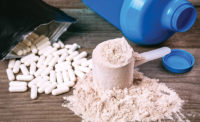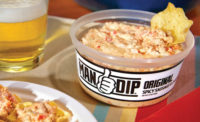The key trends showing up in nutritional supplements and meal replacements are similar to those in other food and beverage categories — a desire for more high-quality protein, clean ingredients, flavor variety and convenience — according to several formulators of protein and functional ingredients with whom we spoke.
Meal replacement dollar sales are forecast to reach $2.5 billion this year in the United States and are expected to grow 9.5% from 2018-2023 to reach $2.7 billion, according to Euromonitor International, London. Likewise, supplement nutrition drink dollar sales are forecast to reach $1.2 billion in 2018, but are expected to decline 4% over that same period to $1.16 billion.
Nutritional supplements are typically showing up as protein powder, beverage and shake formats. Meanwhile, meal replacement products can range from high-protein beverages smoothies or shakes, other ready-to-drink concepts, protein bars and even high-protein snacks and desserts. Protein, specifically high-quality protein, really is the key for manufacturers formulating new products in this market. Other important factors include added vitamins and minerals, added probiotics and lower-sugar profiles, according to formulators with whom we spoke.
Per “A New Era for Protein: Why U.S. Dairy Delivers in the Crowded Protein Marketplace,” a 2018 report from the Arlington, Va.-based U.S. Dairy Export Council (USDEC), 78% of U.S. consumers believe that protein contributes to a healthy diet, and half of them indicated they want more of it in their diets.
In this same report, USDEC emphasized the importance of dairy protein.
“All proteins are not created equal. Whether formulating protein into products intended for vulnerable undernourished populations, sports nutrition, weight management or healthy aging, it is important to choose a high-quality, complete protein. Dairy proteins consistently deliver this important level of nutrition,” USDEC said.
“Flavor, appearance, performance and nutrition all play a role in product enjoyment, but these attributes are balanced with cost and lifestyle considerations,” USDEC added. “In this new era of increased focus on protein, more fortified food options exist than ever before. Finding proteins that consistently deliver on multiple attributes is key.”
In May 2017, Arla Foods Ingredients, Denmark, in conjunction with Denmark-based Lindberg International, released a study, “Global awareness & perception of whey protein hydrolysates,” that showed 56% of global respondents prefer whey protein to other protein types. In this same study, 40% and 38% of respondents said they prefer to consume protein powder and protein bars, respectively. Ready-to-drink protein came in at 21%.
What’s trending
With protein fortification and cleaner ingredient labels dominating the nutritional supplement and meal replacement categories, manufacturers have an opportunity to innovate and even reach a new consumer base.
“There has been a steady trend for protein-packed snacks, meals and supplements that fit a consumer’s specific lifestyle,” said Lindsey Ormond, director of nutrition and research, Milk Specialties Global, Eden Prairie, Minn. “Consumers across the range of body builders to healthy aging are searching for more nutritional ways to nourish their muscles and provide their bodies with ingredients that promote their desired health goals.”
Ormond said that these high-protein foods commonly come as protein powders, beverages and bars.
“However, with this growing trend, we are seeing a rise in unique applications to truly fit every consumer category, from protein breakfast foods to dessert indulgences [such as] protein brownies and cookies,” she added.
Anne Louise Friis, sales development manager, Americas, Arla Foods Ingredients, said her company is seeing an increase in bars containing high-quality dairy proteins. The bars offer a grab-and-go solution for consumers that provide satiety and a high protein content. They can be used as a meal replacement or a nutritional supplement for appetite control, she said.
“One of the more interesting trends we are seeing is the emergence of coffee protein beverages homing in on the coffee trend, but with protein, plus vitamins and mineral blends,” said Vicky Fligel, senior product manager, functional systems for Glanbia Nutritionals, Chicago. “We are also seeing protein moving into different types of beverages such as protein waters and in smaller quantities such as protein pouches and protein shots.”
Naz Aksu, vice president of marketing for AMCO Proteins, Burlington, N.J., said AMCO is seeing three main trends in these categories — cleaning up ingredient labels (as previously mentioned), health benefits of dairy and flavors beyond the traditional.
“Simple is best when it comes to ingredients on a label declaration. Consumers want ingredient names they can pronounce and recognize; this gives an element of trust,” she said. “This trend is being driven by millennials, but very much adopted by boomers across the spectrum.”
Aksu noted that beyond the common known benefits of dairy (calcium and protein), “there’s a movement towards smaller components of dairy with ingredients such as bioactive whey, α-lactalalbumin and β-lactoglobulin, and others.” These ingredients are “gaining speed due to clinical evidence that suggests major health impact such as warding off heart disease, immunological benefits and antimicrobial properties.”
The most popular flavors for meal replacements have traditionally been chocolate, vanilla and strawberry, she noted. But more unique flavors are finding their way into meal replacements and nutrition supplements.
“Increasingly, more culinary type flavors are emerging that combine fruits with spices and herbs such as ginger, green tea and basil,” Aksu said.
Fligel added that there is “a bit of exhaustion with the traditional vanilla and chocolate beverages.” Consumers are seeking more flavor innovation such as fruit-type flavors, she said.
Taste is still a high priority, especially in the better-for-you market, said Georgia Dina Konstantopoulos, communication manager, FrieslandCampina Ingredients North America, Paramus, N.J. Consumers, especially millennials, know they don’t have to compromise on taste to eat healthfully. And product manufacturers need to keep this in mind when formulating new products.
“Segmentation among consumer groups and occasions is another significant trend,” she added. “We are now seeing an increased variety of products that address specific needs, diets and occasions such as paleo and ketogenic diets, overnight recovery, weight loss and active nutrition, to name a few.”
In meal replacements, “convenience is king,” said Aaron Martin, nutrition innovation manager for BiPro USA, a consumer brand of Agropur, Longueuil, Canada. Ready-to-drink dairy protein beverages are trending, he said.
“Ingredient transparency and origin are still trending, but also greater awareness of the beneficial effects of areas beyond dairy are often included,” he added. “For example, formulators include healthy fats, fibers, immunity boosters and vitamin and minerals.”
Martin noted that as consumers become better educated about the benefits of these areas, the demand for more precisely formulated products increases.
Growth drivers
With the target audience for products in these categories now extending beyond body builders and those watching their weight, manufacturers are appealing to busy consumers who are in search of nourishing high-protein meals on the go. And this broader consumer base is contributing to growth.
“We are seeing individuals beyond traditional athletes use dairy protein supplements and meal replacements to achieve and maintain their health and fitness goals,” Martin said.
Conrad Rangell, account manager for BiPro USA, said “this larger scale of health demand” extends to a wide variety of populations such as business professionals, moms, seniors and recreational athletes.
Aksu said AMCO is seeing three main factors driving growth: “stability and availability of raw ingredients, health benefits of dairy proteins as emerging research is published, and the consumer recognition of dairy protein names.”
Besides the high-protein trend driving growth, consumers are increasingly seeking convenience, which is driving growth in healthy snacking and on-the-go offerings, Friis said.
“And, of course, consumers want all these benefits without sacrificing pleasure, so products should also meet their need for healthy indulgence,” she said.
Konstantopoulos agreed that the convenience trend, along with an abundance of available information, is helping drive growth.
“Consumers want to make healthy choices and know that snacks and ready-to-eat meals are no longer associated with bad eating habits and unhealthy on-the-go products,” she said. “Examples include bite-size bars that can be consumed at any time, or having someone else plan your weekly meals and deliver the ingredients to your house.”
Packaging plays an important role in successfully marketing the convenience aspect. Meghan Wahlin, senior category strategy manager for Glanbia Nutritionals, said examples include easy-to-open packaging, products that are consumable straight from the package, single-serving sachets, gummies and stick packs, and products that are easy to transport.
Kimberlee Burrington, certified food scientist, and dairy ingredient applications coordinator for the Center for Dairy Research, Madison, Wis., said adding new flavors to products in these categories can also help drive growth. She suggests mango, coconut or chocolate-peanut butter to provide more variety.
“Most brands are also adding plant-based options to attract a broader base of consumers. Diets such as the paleo or keto diet, which are very protein focused, are also contributing to growth,” she added.
Market these products successfully
We talked to several formulators and experts about how to successfully market dairy-based nutritional supplements or meal replacements — and they shared these tips.
“The current marketplace is seeking to understand the ‘benefits,’ and effectively communicating product benefit will be key,” Aksu said. “Knowing what the end-user benefit will be for the consumer will be the secret sauce to marketing [these products].”
Regarding the increased interest in plant-based proteins, Aksu acknowledges the trend, which she said is being driven by millennial spending but believes interest will eventually level off.
“Due to the developmental challenges of most plant-based proteins and high costs, as compared to the relatively ease of use of dairy proteins and comparatively lower costs, the likelihood of plant-based proteins overtaking dairy is slim,” she stated. “Another tactic that marketers can use is to drive development of products that blend dairy and plant-based nutrition together. Both have valid space on the shelves, and both are powerhouses that facilitate healthy lifestyles.”
Konstantopoulos attributes the increased interest in plant-based proteins to the perception that they are more ‘natural,’ sustainable and healthful than their dairy-based counterparts.
“As part of the dairy industry, we need to help our customers better explain to the consumer the different benefits dairy has and that there is no one-size-fits-all approach,” she said.
A focus on product taste, the quality of the protein and consumer education are all important when marketing a product, added Candyce Lefeber, account manager for BiPro USA.
Perri Gordon, brand marketing director, Core Power & Smart Snacks for fairlife, Chicago, said it’s important to highlight the product’s best asset such as the high nutritional content of dairy milk.
“Not only does the quality of protein stand out from plant-based in terms of efficacy, but it signals simplicity to consumers,” she said.
Burrington said it’s up to the dairy industry to give manufacturers the tools to communicate with their consumers about the health benefits of consuming dairy proteins.
“The consumers of supplements are probably not aware that, in most cases, they would need to consume more servings of a plant-based protein supplement to obtain an equivalent number of essential amino acids, especially leucine,” she said.
Max Maxwell, manager, market intelligence for Glanbia Nutritionals, said manufacturers need to embrace “the science behind dairy and dairy ingredients.” He suggests “celebrating dairy with engaging cow images and using terms like dairy fresh and farm fresh” when marketing products.
Knowing the audience for your products is also important.
“Aging consumers are looking for holistic and positive claims on products,” said Maarten van Beek, global director, medical nutrition and healthy aging for NZMP, a dairy ingredients brand of Fonterra, Auckland, New Zealand. “But apart from product claims, other things like ease of use, online purchasing options, packaging designed for limited dexterity, and larger fonts on labels are important.”






